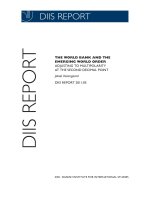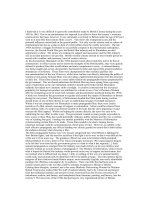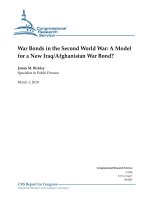The second world war
Bạn đang xem bản rút gọn của tài liệu. Xem và tải ngay bản đầy đủ của tài liệu tại đây (4.59 MB, 282 trang )
The Second World War
The Second World War
A People’s History
JOANNA BOURKE
1
3
Great Clarendon Street, Oxford ox2 6dp
Oxford University Press is a department of the University of Oxford.
It furthers the University’s objective of excellence in research, scholarship,
and education by publishing worldwide in
Oxford New York
Athens Auckland Bangkok Bogotá Buenos Aires Cape Town
Chennai Dar es Salaam Delhi Florence Hong Kong Istanbul Karachi
Kolkata Kuala Lumpur Madrid Melbourne Mexico City Mumbai Nairobi
Paris São Paulo Shanghai Singapore Taipei Tokyo Toronto Warsaw
with associated companies in Berlin Ibadan
Oxford is a registered trade mark of Oxford University Press
in the UK and in certain other countries
Published in the United States
by Oxford University Press Inc., New York
© Joanna Bourke 2001
The moral rights of the author have been asserted
Database right Oxford University Press (maker)
First published 2001
All rights reserved. No part of this publication may be reproduced,
stored in a retrieval system, or transmitted, in any form or by any means,
without the prior permission in writing of Oxford University Press,
or as expressly permitted by law, or under terms agreed with the appropriate
reprographics rights organizations. Enquiries concerning reproduction
outside the scope of the above should be sent to the Rights Department,
Oxford University Press, at the address above
You must not circulate this book in any other binding or cover
and you must impose this same condition on any acquirer
British Library Cataloguing in Publication Data
Data available
Library of Congress Cataloging in Publication Data
Bourke, Joanna.
The Second World War : a people’s history / Joanna Bourke.
Includes bibliographical references and index.
1. World War, 1939–1945 I. Title.
D743 .B62 2001
904.53—dc21
2001045152
ISBN 0–19–280224–0
1 3 5 7 9 10 8 6 4 2
Typeset in New Baskerville
by RefineCatch Limited, Bungay, Suffolk
Printed in Great Britain
on acid-free paper by
Biddles Ltd, Guildford and King’s Lynn
Contents
List of Figures
vii
List of Maps
ix
1 Introduction
1
2 The Declaration of War in Europe
8
3 Occupied Europe
25
4 Battle of the Atlantic
47
5 War in China, Burma, and India
55
6 War in South-East Asia and the Pacific
74
7 Italy, the Balkans, and the Desert
100
8 The Eastern Front
119
9 The Holocaust
137
10 Liberating Europe
162
11 Hiroshima
175
12 Aftermath
190
13 The Memory of War
216
Notes
227
contents
Chronology
237
Further Reading
247
Index
251
vi
List of Figures
1
‘Rendezvous’, showing Hitler meeting Stalin over the NaziSoviet Non-Aggression Pact (cartoon by David Low).
2
Polish girl weeping over her sister, killed by German
bombing of Poland.
3
The Battle of the Atlantic from the Allies’ point of view
(cartoon by Stephen Roth, Czech artist in exile in
London).
4
Japanese warship under attack by an American bomber,
near Amoy, China, 6 April 1945.
5
Chinese militia and peasants destroying a railway line to
impede the Japanese in North China, 1941.
6
Severed head of a Japanese soldier hanging from a tree in
Burma. It was presumably put there by American soldiers.
7
‘Eastern Pirate’s Speciality’ (cartoon by Cai Ruohong).
The bodies on the ground are labelled ‘people’.
8
American POWs with their hands tied behind their backs,
just before starting the Death March out of Bataan in April
1942.
9
Japanese POWs, captured on Bataan, being led blindfolded to the Headquarters for questioning (undated).
10
A survivor of Kalagon Village, north of Moulmein in
Burma, picking out members of the Kempeitai at an identity parade at Moulmein Jail.
list of figures
11
‘The Heroines of 1940’, a Greek poster in tribute to the
Greek resistance to the Italian invasion of 1940.
12
‘Grief, Kerch, 1942’: the aftermath of a Nazi massacre of
civilians at Kerch, in the Ukraine (photograph by the
Soviet photographer, Dmitri Baltermants).
13
‘Zoya Kosmodemyanskaya, Tania’: a partisan tortured to
death by the Germans (photograph by Serguei
Strunnikov).
14
Street fighting in Stalingrad, 1942.
15
Russian cartoon by Koukrinikci. The Russian text says,
‘Napoleon suffered defeat. The same thing will happen to
Hitler’.
16
A group of Jewish women, some with babies in their arms,
before their execution in Misocz, Ukraine, 14 October
1942. Local collaborators are shown assisting the
Germans.
17
A Jewish girl being terrorized by a Ukrainian mob.
18
The effect of a firestorm in Hamburg, August 1943.
19
‘Travel Orders (1945)’ (cartoon by George Baker, published in Yank). ‘Sad Sacks’ was an army term for a useless
soldier or a ‘sad sack of shit’.
20
‘Ground Zero’, Nagasaki on the morning of 10 August
1945 (photograph by Yamahata Yosuke).
21
‘Young War Victims, Rome 1948’, showing limbless children playing (photograph by David Seymour).
viii
List of Maps
1
Europe, 22 June 1941.
2
The Far East, showing the Japanese attacks between
December 1941 and March 1942.
3
The locations of the main concentration and death camps.
4
The percentage of Japanese cities destroyed by Allied air
attack.
1
Introduction
N
o one has said that killing is easy. Yet, war depends
upon large numbers of people being prepared to
slaughter large numbers of other people. In the
modern period, the Second World War took this commonplace military requirement to new depths. It left a devastated world in its wake. The map of the world had to be
redrafted. Entire economies had been destroyed, but the
psychological burden of mass human destruction was
incalculable. For many people, the physical and psychological havoc was difficult to bear. As one young American
infantryman stammered after stabbing to death a man with
his bayonet: ‘that bothered me . . . my father taught me
never to kill.’
The stark ugliness of combat escaped no one. The killers—
mainly young men, but also many women, children, and the
elderly—rarely avoided the feelings of panic, disgust, and
despair that accompanied acts of grotesque brutality. The
writer William Manchester recalled that, after killing a Japanese soldier in the Pacific, he cried ‘I’m sorry’ and started
sobbing, before vomiting and urinating in his uniform. The
victims too came from every age group, gender, class, and
1
introduction
nationality. Some were executioners before they became
victims. Terror was always a central component of this war.
Military campaigns, strategy, and ‘collateral damage’ are
important aspects of war, but injuring and destroying human
beings is at the heart of military conflict. War involves killing
people: the multiple ways in which this could be achieved
were never so clearly demonstrated as during the Second
World War.
Total War
The Second World War was the greatest cataclysm in modern
history. This was truly a ‘world war’. Just compare this conflict with its major predecessor. During the First World War,
twenty-eight states participated in the bloodletting. Sixty-one
states leapt at each other’s throats between 1939 and 1945.
The dedication of the entire globe to the waging of war and
the breaking-down of distinctions between the battlefield
and the home front were the chief traits of this conflict.
Without question, the Second World War propelled the
notion of ‘total war’ into dizzily horrifying heights. Indeed,
civilians were the victims-of-choice. Again, this is most starkly
brought out by a comparison with the First World War. While
only 5 per cent of deaths in the 1914–18 war were civilian
deaths, 66 per cent of deaths in the 1939–45 war were
of civilians. Many more civilians than military personnel
were killed in Belgium, China, France, Greece, Hungary,
the Netherlands, Norway, Poland, the Soviet Union, and
Yugoslavia. Furthermore, by whatever definition we use, large
proportions of these victims were indisputably innocent. This
2
introduction
book contains many examples of this frightening fact. The
Holocaust is the pre-eminent instance of the wanton slaughter of non-combatants. But this was also the case in many
other campaigns of the war. For example, of the six million
Poles ( Jews and non-Jews) who were killed by the Germans,
one-third were children.
Finally, the Second World War deserves its reputation as
the most horrifying event in modern history for the way in
which processes of dehumanization and killing were
founded upon so-called rational calculation. Science and
technology were applied to the most murderous ends known
to humankind. The range of uses was astounding, involving
impersonal aerial bombardment, depersonalized murder in
gas chambers, and face-to-face executions of entire communities. It is no wonder that, for the 85 million men and
women who served (and survived) in one of the armed forces
during the war and for the vast population of people caught
up in the slaughter (and surviving), the war was the most
unforgettable moment in their lives.
Confusion and complexity are the dominant characteristics of this ‘total war’. For this reason, every history of the
Second World War is necessarily fractured and incomplete.
This is even more the case in a book of this brevity. Each
participating nation tells a separate story of ‘the war’ and
very few points of agreement can be found. Even such basic
questions such as ‘what’, ‘when’, and ‘who’ are disputed.
What is this military conflict called? For the British it is the
Second World War, while the Americans call it World War
Two; for the Russians it is the Great Patriotic War, while the
Japanese designate it the Greater East Asia War. There is wide
disagreement about the name of the most atrocious event of
3
introduction
the war: the massacre of 6 million Jews. Should it be called
the Holocaust, the Shoah, ‘the Event’, a genocide, an
extermination, a mass murder, ‘l’univers concentrationnaire’, or even the Nazi phrase, ‘the Final Solution’? This
book will use the word ‘Holocaust’, Greek for ‘whole burning’ or ‘burnt sacrifice to God’. But what do these words
mean for the 14–16 million non-Jews who were also victims
of Nazi mass murder? After all, Poles, Slavs, and Gypsies were
also targeted for genocidal slaughter, and German Communists, Jehovah Witnesses, ‘asocial’ criminals, mentally and
physically handicapped, the chronically ill, and homosexuals
were victims as well.
On a more prosaic level, when did the war begin? Some
Japanese date it from 1931 (or Shõwa 6, according to the
Japanese calendar), when their troops occupied Manchuria,
a border province of China. This heralded what the Japanese call ‘the dark valley’ (or kurai tanima), a decade and a
half of war. Britain, France, and the Commonwealth countries date the war from September 1939, although the British
public experienced a lengthy period of the ‘phoney war’
until April 1940. For the Russians, war really began in June
1941, despite the fact that the Red Army was already engaged
in battle in Finland. The Americans got on board only in
December 1941 (but their ships were implicated well before
that date).
Also, of course, the enemy differed depending on which
‘side’ you were on—and that could change quite rapidly.
Even within a single country, there may not be agreement on
the nature of the enemy. For instance, a Pole in Lwow had
good reasons to fear the Russians or Ukrainians, while a
Pole in Warsaw was more liable to feel terrorized at the
4
introduction
appearance of Germans. Americans on the East Coast might
be slightly more anxious about the German threat, while
West Coast residents were much more worried over Japan.
Finally, for millions of combatants and non-combatants
alike, the greatest enemy did not possess a human face at all.
‘Nature’, with indiscriminate fury, could attack at any time.
As one American private serving in Lorraine cursed: life was
‘a goddam-muddy-field where a man’s feet were always wet, a
sonofabitch-of-a-sky that threatened rain, a pain-in-the-ass-ofa-woods from which a Heinie sniper could fire at us and stay
hidden for hours’. In the war in Eastern Europe, the harsh
climate competed successfully with artillery shells and bullets
in killing people. The German soldier Bernhard Bechler
described the situation he found himself just outside
Stalingrad:
Just imagine the scene: steppe, everything frozen, sub-zero
temperatures of minus 20 or 30 degrees, masses of snow . . .
German soldiers were lying on the ground and German tanks
ran over these soldiers because they were no longer able to
get up and make themselves known. I was thinking to myself,
subconsciously: if people at home could see us here, if they
could only see our soldiers dying so wretchedly!1
Wherever you stood or crouched, there lurked an ugly and
violent death.
Telling War Stories
Inevitably, this is neither an easy nor a pleasant story to tell.
It is legitimate to ask why we even need another history—and
a very short one at that—of the Second World War. It is
5
introduction
impossible not to sympathize with some commentators who
insist that it is impossible to speak about certain aspects of the
war. In particular, they argue that even attempting to write
about the terrors of the Holocaust implicates us vicariously
in the horrors that were perpetrated. They are concerned
that attempts to ‘explain’ the deeds of the perpetrators will
render their actions ‘understandable’ and therefore ‘forgivable’. The Holocaust is, and should be, literally unspeakable.
The psychoanalyst and former Dachau prisoner Bruno
Bettelheim put it succinctly: ‘There are acts so vile that our
task is to reject and prevent them, not to try to understand
them.’
For commentators who believe that the Holocaust is literally ‘unspeakable’, no argument will change their mind, but I
cannot embrace their silence. It is clear that the
participants—victims as well as perpetrators—are impelled
by the need to tell their stories, to communicate what happened, to search for a ‘why’, and to attempt to forge some
kind of meaning out of the chaos that was their individual
experience of the Holocaust. Today there is an even more
pressing reason to speak and write about such events: a new
generation is among us who possess little or no knowledge of
this war. We are at risk of ‘forgetting’. As the survivors gradually die, their memory is being overtaken by stories told by
the victors and (most disturbingly) by ‘Holocaust deniers’—
powerful groups with their own extreme right-wing political
agendas. There is also the threat that the translation of ‘the
war’ into just another story of battles and strategies will dilute
its horror. The sanitization of the war in some military histories is dangerous. Mass slaughter becomes a bland recital of
‘body counts’. The anonymous enumeration of millions of
6
introduction
men, women, and children killed or wounded, the numbing
statistics estimating the proportion of cities destroyed, and
the meaningless recital of the weight of various armaments
can distance us from the victims. A similar process of
dehumanization enabled atrocious behaviour to take place
during the war. When Joseph Stalin (the dictator of the
USSR) quipped that ‘a single death is a tragedy, a million
deaths is a statistic’, he was drawing attention to a very frightening possibility. In the perhaps apocryphal words of the
historian Simon Dubnov, just before he was killed by a
Lithuanian policeman during the destruction of the Riga
ghetto: ‘Good people, do not forget, good people, tell
your story.’2 If this People’s History errs in omitting too many
strategic intricacies and technological advances in order to
allow individual participants to tell us about their experiences, I hope that I will be excused. Admittedly, it would be
ludicrous to imply that the individuals who appear in this
book are in any way ‘representative’, ‘typical’, or even necessarily ‘ordinary’. Nationality, gender, class, age, political
beliefs, and so on single out these individuals from all
others—but they serve to remind us of some of the people
upon whom the brunt of the war fell. It is to be hoped that
readers will be stimulated by this book to follow up their
reading by looking at the mass of other material—written
from different perspectives—that proliferates on library
shelves.
7
2
The Declaration of War in Europe
A
mere twenty years after the rivers of blood flowing
from the First World War had been staunched, the
European Powers embarked on further carnage. In
1918, people in all participating nations had united to recite
the Hungarian slogan nem, nem, soha! (‘no, no, never!’).
Poets and novelists were at the forefront of this movement.
After the First World War, politicians, religious leaders, and
pacifists in all the warring nations had emphasized time and
again the need to learn from the carnage between 1914 and
1918. In the words of the French pacifist Édouard Herriot, in
a speech on 1 February 1925 appealing for money for a
peace monument, ‘It is we pacifists who are the most true to
the teachings of the war.’1 But the slaughter was to start anew,
and the actual experience of this conflict was to deal a cruel
blow to the high ideals of anti-war commentators throughout
the world. How could this have happened?
8
the declaration of war in europe
Origins of the European War
No one agrees on the origins of the war in Europe. The
desire to locate its beginnings in a single ‘event’ or ‘tendency’ has obscured the multifarious origins of this complex
military conflict. There is also the question of how far back
into history we must search for a cause. Many historians trace
the origins of the Second World War to the earlier ‘world
war’. Indeed, they argue that the Second World War cannot
be clearly distinguished from the First World War: what
Europeans experienced was a ‘Thirty Years War’ of the
twentieth century. We may not wish to go that far, but it is
true that imposing the humiliating Treaty of Versailles
(1919) on the defeated powers and forcing them to mortgage their economies with an outlandish reparations bill set
up a marker for another major conflict. As one historian put
it: ‘Powers will be Powers.’2 In other words, it was inevitable
that Germany would seek to regain what it regarded as its
rightful place in the world.
In Germany, the Treaty of Versailles was followed by
rampant inflation and then, after a brief breathing space, by
a severe economic depression: it was not unexpected that
many Germans responded by looking back to the glorious
days of the Wilhelmine Empire. But by 1938, under the
Nazis, the economic outlook in Germany had changed.
The economic recovery fuelled the sense of injustice that
had arisen in the aftermath of the First World War. The
strength of the German economy had resulted in a balanceof-payments crisis caused largely by the need to pay for
the dramatic increase in imports of food and raw material.
Industry and rearmament required ever more resources—
9
the declaration of war in europe
and Hitler’s regime was increasingly looking outside Germany to meet these needs.
Furthermore, defeat in the First World War had failed to
remove Germany’s eastward ambitions. Adolf Hitler successfully played upon this national obsession. In this sense,
Hitler’s policy was fundamentally one of continuity with
German politicians prior to 1918 and during the Weimar
period. When Hitler came to power in 1933, National
Socialism seemed to hold out the promise of a revived
Germanic nation. Hitler did not invent many of the ideas
that led to war. His promotion of the supposed need for
Lebensraum (or ‘living space’) can be traced back to the
nineteenth century, and his racist Social Darwinism was
widely accepted by the early twentieth century in Germany.
Finally, although Hitler’s pathological hatred of the Jews is
unquestioned (in Mein Kampf he called them subhumans, a
cancer that had to be removed), the belief that Jews were
responsible for all of Germany’s ills—and particularly its
fate during the First World War—was widely held by many
Germans, on the hard and soft right, and originated in the
rise of racial anti-Semitism in late Imperial Germany.
This emphasis on the ways Hitler epitomized wider concerns within German society in the 1930s can easily lead to
a crude reductionism that employs a very simple equation:
no Hitler, no war. It cannot be disputed that Hitler was a
domineering political personality in Germany. It is difficult
to imagine the Third Reich without him. He possessed a
fanatical will and was at the same time an unprincipled
opportunist. His desire to gain Lebensraum for his ‘Aryan
race’ in Eastern Europe was wholehearted. As he wrote in
Mein Kampf:
10
the declaration of war in europe
To demand the borders of 1914 is political nonsense of such
a degree and consequence that it appears a crime . . . The
borders of 1914 meant nothing to the German nation . . . We
National Socialists, by contrast, must without wavering keep
to our foreign policy aim, which is to secure to the German
nation the soil and space to which it is entitled on this earth.3
Nor is there disagreement about his willingness to impose his
will upon all his subordinates. When any of his subordinates,
like his first Foreign Minister, Konstantin von Neurath,
seemed reluctant to follow his lead into war, they were
replaced. However, it is far too easy to be carried away by this
image of the ultimate in human evil. Indeed, this image of
Hitler is largely a construction of Nazi as well as Allied
propaganda. It is dangerous to place too much emphasis
upon Hitler as a cause of the war—whether as a personality in
his own right or as someone who managed to epitomize
wider and more entrenched national desires and ideologies.
Much evidence suggests that Hitler had no coherent plan.
Certainly, he was willing to risk millions of his own people
in the pursuit of a racially ‘pure’, rejuvenated, Greater
Germany. But he was more likely simply to take advantage
of things as they happened, rather than working to a
pre-planned strategy. Too much of the explanation for the
origins of war has been placed on Hitler’s lust for domination, and not enough on the expansionist ideology of
Nazism.
However, if focusing on Hitler is a form of reductionism, so
too is an excessive emphasis on ideology. Some historians
want to claim that the war grew out of a conflict of competing
ideologies. Totalitarianism in Germany, Italy, and Japan
faced up to the liberal democracies of Britain, France, and
11
the declaration of war in europe
the United States. According to this argument, the Axis
countries—and Germany in particular—failed to develop
a strong liberal-democratic tradition. In other words, the
problem was not Hitler but Germany. Hitler’s anti-Semitism,
virulent nationalism, and antisocialism were simply more
extreme than those shared by earlier German leaders and
‘ordinary Germans’. This explanation is also unsatisfactory.
The problem with blaming ‘fascism’ is that it fails to differentiate between the very different forms of this political
ideology. Italian fascism was very distinctive from National
Socialism, and neither resembled Japanese totalitarianism.
Finally, the origins of the war may also be traced to strategic concerns. War was inevitable if the territorial ambitions
of certain nations were to have any hope of being achieved.
Germany and Italy believed that they had something to gain
from war. Hitler’s plan vastly to expand the amount of land
available for exploitation by the Aryan race in Eastern
Europe has already been mentioned. The Italian dictator,
Benito Mussolini, also pursued a foreign policy that was
concerned with the supposed need for spazio vitale (again,
‘living space’) for Italians in North Africa and the Middle
East. Mussolini’s willingness to act upon this need was clearly
signalled in October 1935, when Italian troops from neighbouring Italian Somililand and Eritrea invaded Abyssinia
(modern-day Ethiopia). A year later, Italy and Germany
militarily supported General Francisco Franco, the fascist
dictator in Spain. Franco’s victory in 1939 was a major
economic as well as political coup for both powers. Spain’s
iron ore, tin, copper, zinc, and mercury were henceforth at
their service. Mussolini also had ambitions of establishing
Italy as one of the Great Powers. Thus, when Mussolini signed
12
the declaration of war in europe
the Pact of Steel with Hitler in May 1939 (which committed
Germany and Italy to support each other with all their military forces ‘on land, sea, and in the air’), he signalled his
desire dramatically to extend Italy’s ‘Roman’ empire.
Strategically, the origin of the war was more complex for
the Soviet Union. At first, Stalin pursued a defensive foreign
policy. The Nazi–Soviet Non-Aggression Pact of August 1939
decreed that Russia would remain neutral should Germany
attack Poland. For Stalin, it was an attempt to protect the
Soviet Union from German aggression. Stalin signed the
Pact only after his attempts to find agreement with Britain
and France had been rebuffed. The Pact came as a surprise
to the other Great Powers. After all (as Figure 1 illustrates),
Hitler regarded the Russians as the ‘scum of the earth’, while
Stalin viewed Hitler as the ‘bloody assassin of the workers’.
Whatever Stalin’s long-term plans involved, it is clear that
Hitler always intended the Pact to be a short-term strategy. In
the words of the German ambassador to Italy, Ulrich von
Hassell, in his diary of 29 August 1939:
About the Russian pact Hitler said that he was in no wise
altering his fundamental anti-bolshevist policies; one had to
use Beelzebub to drive away the devil; all means were justified
in dealing with the Soviets, even such a pact as this. This was a
typical example of his conception of ‘Realpolitik’.4
However, in the short term at least, the Pact proffered a great
prize to the Soviet Union. The Pact had a secret clause dividing Poland between Germany and the Soviet Union. Stalin
clearly understood that the Soviet Union needed to protect
itself—and one way Stalin conceived of doing this was by
creating a buffer zone.
13









